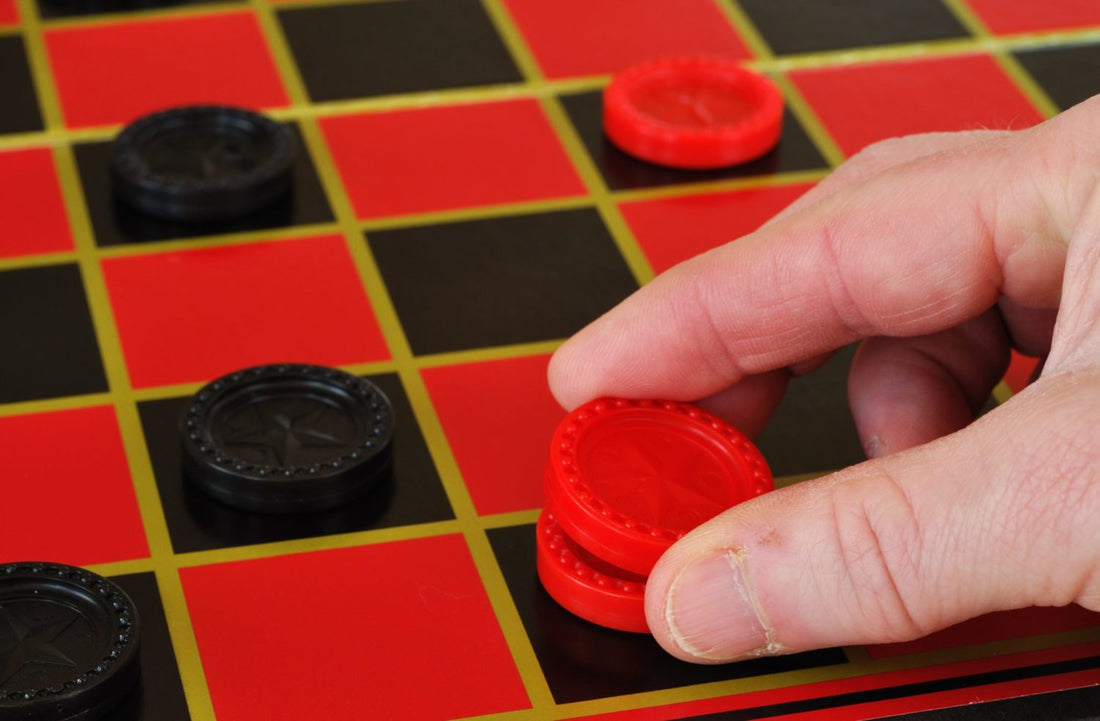
How To Play Checkers | Checkers Rules and Complete Tutorial
Share
What is checkers?
Checkers is a classic board game where players try to jump over and capture their opponent’s pieces. A player wins when their opponent has no more pieces left. Checkers is a timeless game because it’s strategic, yet simple enough that it’s fun for almost all ages.
Objective
The goal of checkers is to capture all of your opponent’s pieces, so that they have none left on the board. Although less frequent, players can also win if they trap their opponent so that there are no moves available.
Number of players
Checkers is a two player game.
Age
Checkers is good for all ages, but kids start understanding the moves and strategies around four years old.
What you need to play checkers
- Checkers board: 8x8 checkers board (same configuration as a chess board)
- 24 checkers: 12 checkers of one color and 12 of another color
Skills
- Social skills: Players take turns, communicate with the other player, and learn sportsmanship.
- Strategy: Checkers is a game of strategy and players can improve to become good players.
Why we like it for kids and families
Checkers is one of the earliest strategy games that kids can play (and get good at) and is still fun as adults too. It’s a great family game for all ages. It’s also popular so it’s a game that’s possible to play with anyone.
How to play checkers
1: Grab a checkers board and 2 players
All you need to play checkers is two players, a checkers board, and the 24 checkers that come with it (in two colors).
2: Determine who goes first
One player will put one red disc in one hand and one black desk in the other hand and hold out their fists to their opponent. The opponent picks one hand. Whatever color the player picks is their color (and black goes first). You can also use any other method, such as rock paper scissors, flipping a coin, etc.
3: Set up the checkers board
Position the board: The game is traditionally played only on the black boxes, with the light corner spot to the right of each player for consistency (more advanced players have specific numbers to designate each spot and the moves they make). The board should be placed between the two players, who should be facing each other. Place the checkers: Each player put all the pieces on the black spots in the 3 rows closest to them.
4: Play the first turn
In the traditional game, the starting player always plays the black checkers. They may move any piece forward, diagonally, in their first row.
5: Alternate turns
The other player plays their turn, also playing one piece, diagonally, forward.
6: Continue alternating play, while following the rules
Players will continue to alternate play, but as the game progresses, new moves become available, such as jumps, double jumps, and forced moved. And a new type of piece, a king, become available with special powers. Here are the fuels players follow: Single checkers
- Can only be moved forward, diagonally, one spot, for normal moves
- Can “capture” an opposing piece if they are adjacent to that piece and there is an empty space directly behind it. A player will jump over that piece, land, and then remove the opponent’s jumped piece from the board.
- Can “capture” multiple pieces from an opponent if they are adjacent to the first piece and there is a spot open directly behind it. If where they land also has an adjacent piece with an open spot behind it, then can complete a second hop. All pieces that were jumped are removed from the board.
- Become kings if they reach their opponent's back row.
King checkers
- Get promoted to a king when they reach the opponent’s back row. The king is designated by stacking a second checker on top of it.
- Can move diagonally in any direction.
- Can capture pieces in the same way as a single piece, but can also go both forward and backward
7: Declare a winner
A player wins when they have captured all of their opponent’s pieces. They can also win if their player has no moves available. A draw is declared when neither player is able to force a win. Usually, players agree on a draw if they both have 2 or fewer pieces left (unless there is an advantage like 2 kings vs 2 singles). For tournament play, a game is usually declared a draw if 40 moves have passed since the last capture, or if the same move is repeated 3 times in a row.
Checkers video tutorial
Checkers rules
- Players must move a checker during their turn. No passing.
- Play is always diagonal in direction, on black spaces.
- Only kings can move in either direction (forward and backward). Single checkers may only move forward.
- You may only capture an opponent’s piece if you are adjacent to it and the spot immediately behind it is open.
- You MUST jump if a jump move is available. This includes additional jumps in a multi-jump move.
- No jumping off the board (if the opponents piece is on the edge)
- If multiple jumps are available, you may choose which one
How to win in Checkers | 6 winning strategies
https://www.youtube.com/watch?v=Lfo3yfrbUs0 Checkers is a game of skill. Here are 6 strategies, as outlined in the video above, to help you win.
- Control the center 8 pieces
- Trade pieces when you’re ahead
- Use forced jumps
- Be the first to get a king
- Don’t be afraid of being near opponent
- Build a line
Checkers glossary
- Capture: A legal move where you jump over an opponent’s adjacent pieces when the spot immediately behind it is open. Also called a jump. When you capture an opponent’s piece, you remove it from the board.
- Double jump: Players may do multiple captures in one move as long as there is an empty spot behind the piece in the direction they’re jumping.
- King/Promotion: A single piece is promoted to a king when it reaches the back row of the opponent’s board. A king can move in either direction (forward or backward) diagonally.
- Long jumping: An illegal move where a player tries to jump over 2 pieces in a row. Draw: A tie game when neither opponent is able to force a win.
- Stalemate: Unlike chess, there is no stalemate in checkers. A stalemate is a declared tie when an opponent is unable to move. In checkers, if your opponent has no moves, they forfeit and you win.
- Single checker: (i.e. not a king): Single checkers can move forward, diagonally, one space at a time (except when jumping).
Checkers variations
American Checkers (aka English draughts, or draughts) is the most common version of the game and is what’s outlined in this article. But there are many other variations.
Checkers FAQs
General Checkers FAQs
Is checkers harder or chess?
Chess is generally considered harder than checkers because it has many more move variations.
What is the best first move in checkers?
The best first move for the first player is to play the piece second from the left, up diagonally to the right. This is known as an 11-15 as it’s a move from spot 11 to spot 15.
Checkers Rules FAQs
What jumps are allowed in checkers?
- A single piece can jump over an opponent’s piece (either single or king) as long as it is adjacent to it, jumps diagonally forward, and lands in an empty space directly behind it. A king piece can jump either diagonal forward or backward.
- Double jumps (and multiple jumps) are allowed, including a change of direction, as long as it is diagonal forward, and that the jumping piece lands in a spot immediately behind the jumped piece after each jump.
Checkers rules do you have to jump?
If a jump is available, you must play it. This includes additional jumps during a multi-jump opportunity. If there are multiple jump moves available, you may choose which one to play.
What are the checkers rules for the king?
- A single piece gets promoted to a king when it reaches the back row.
- A king piece can move in either direction
- A king in checkers can only move one forward and backward, one diagonal move at a time, except when jumping.
- A king can jump a piece diagonally that it is adjacent to, as long as the piece immediately behind it is open.
- A king can do multiple jump captures, just like single pieces, as long as each piece it is jumping over has an empty space behind it. Unlike a single pieces, a king can jump either forward or backward diagonally, and it can change directions during the multi-jump (as long as it is diagonal).
- A king can be jumped.
Can you get a stalemate in checkers?
No. There is no stalemate in checkers. Unlike chess, in checkers, if a player is unable to move, they forfeit and their opponent wins. There is, however, a “draw.” It usually happens when players are down to their last piece or two and are unable to force a win and they agree to end in a draw. In tournament play, a draw automatically occurs if 40 moves are made without a capture, or if a player plays the same move 3 times in a row.
Play checkers online FAQs
Is there a way to play checkers online?
Yes. There are many checkers games available online. Some are single player against the computer or double player for you and an opponent. Other online checkers sites allow you to play other players online.
What is the best checkers website?
If you just want to play the computer, you can CardGames.IO allows you to play without registering or signing up.







